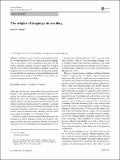The origins of language in teaching
Abstract
I introduce seven criteria for determining the validity of competing theories for the original function of language. I go on to present a novel explanation that meets all the criteria: language originally evolved to teach kin. I suggest that the use of symbols subsequently generated evolutionary feedback at two levels, in the form of self-modified selection pressures that favored structures in the mind that functioned to manipulate and use symbols with efficiency, and cultural selection on languages for learnability.
Citation
Laland , K N 2017 , ' The origins of language in teaching ' , Psychonomic Bulletin & Review , vol. 24 , no. 1 , pp. 225-231 . https://doi.org/10.3758/s13423-016-1077-7
Publication
Psychonomic Bulletin & Review
Status
Peer reviewed
ISSN
1069-9384Type
Journal article
Description
Research supported in part by a grant from the John Templeton Foundation.Collections
Items in the St Andrews Research Repository are protected by copyright, with all rights reserved, unless otherwise indicated.

